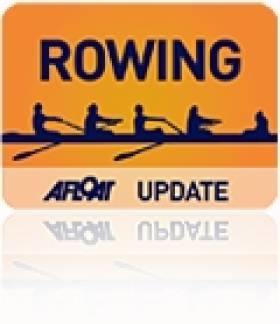Displaying items by tag: Catriona Jennings
Ireland Rowers O'Donovan, McCrohan and Puspure Excel in Trial
#ROWING: On a day with a spread of excellent performances, Paul O’Donovan, Siobhán McCrohan and Sanita Puspure topped the rankings in their classes at the Ireland trial on Newry Canal. O’Donovan, a 19-year-old lightweight sculler, was the fastest man on the day. He clocked 19 minutes 5.46 seconds for the five kilometres, which made him the fourth fastest crew, only bettered by three heavyweight pairs.
McCrohan’s return was also remarkable. The Galway lightweight, who was cut by the previous Ireland coaching regime, shaded O’Donovan in terms of per centage of projected world gold medal time, with a superb 87.43 per cent. Puspure, a heavyweight sculler who had a 2013 to forget because of injury, also excelled, with 86.99 per cent despite a brush with a tree and hitting a buoy in the headwind conditions.
Both men’s and women’s lightweight classes could boast a depth in good performances: Catríona Jennings, a former Olympian marathon runner who is new to rowing, reaced 86.26 of projected world best time as a lightweight sculler. Heavyweight sculler Monika Dukarska also performed well in finishing second to Puspure.
Ireland Trial, Newry, Saturday (Run over 5km; Selected Results)
(Percentage is of projected world gold medal winning time)
Men
Pair – Senior: 1 D Neale, C Folan 18 minutes 41.53 seconds (82.03), 2 D Power, P O’Connell 18:53.62 (81.6). Under-23: 1 R O’Callaghan, R Bennett 18:29.53 (82.92), 2 M Pukelis, K Neville 19:23.43 (79.08). Junior: D Keohane, B Keohane 19:06.58 (80.24), 2 Murphy, O’Connell 19:26.23 (78.89), 3 Fallon, Bennett 19:32.47 (78.47).
Lightweight: 1 Quinlan, O’Connor 19:27.59 (81.36), 2 McKenna, Murphy 19:30.72 (81.15), 3 Keane, Breen 19:32.55 (81.02).
Sculling,
Single – Senior: 1 J Keohane 19:16.47 (84.31), 2 A McEvoy 19:37.34 (82.81). Under-23: 1 T Oliver 19.47.82 (82.08), 2 A Harrington 19:52.47 (81.76), 3 S McKeown 20:06.03 (80.84). Junior: 1 D O’Malley 19:41.55 (82.5), 2 C Carmody 19:57.29 (81.43), 3 C Hennessy 20:15.6 (80.21).
Lightweight – Senior: 1 N Kenny 19:18.40 (86.33), 2 J Ryan 19:28.13 (85.61), 3 M O’Donovan 19:30.07 (85.46). Under-23: P O’Donovan 19:05.46 (87.3), 2 S O’Driscoll 19:26.18 (85.75), 3 C Beck 19:41.35 (84.65).
Women
Four – Senior: Deasy, McCarthy, O’Brien, Leahy 19:51.76 (84.33).
Pair – Senior: L Dileen, A Keogh 20:12.32 (84.14), 2 Bennett, Gilligan 21:28.79 (79.14). Under-23: G Collins, O Finnegan 21.05.13 (80.62). Junior: 1 K O’Connor, H Hickey 21:43.08 (78.28), 2 Clarke, Glover 21:54.75 (77.58), 3 Nagle, O’Keeffe 22:33.06 (75.38).
Sculling
Single – Senior: 1 S Puspure 20:21.36 (86.99), 2 M Dukarska 2:40.57 (85.65), 3 E Moran 21:20.92. Under-23: 1 C Fitzgerald 21.50.12 (81.10), 2 H O’Sullivan 22:14.21 (79.64), 3 M Dineen 22:27.69 (78.84). Junior: 1 E Lambe 21:47.62 (81.25), 2 J English 21:54.17 (80.85), 3 E Barry 22:03.17 (80.30).
Lightweight – Senior: 1 S McCrohan 20:58.15 (87.43), 2 C Jennings 21:15.24 (86.26), 3 O Hayes 21:18.60 (86.03). Under-23: 1 R Morris 21:32.68 (85.09), 2 S Horgan 21:47.18 (84.15).
























































